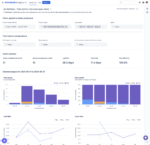Atlassian’s JIRA and Confluence collaboration tools were the focus of the first full day of the company’s developers conference in San Francisco today. The company’s cofounder, Mike Cannon-Brooks, kicked off the conference with a look at the future of Atlassian’s numerous development tools. A key part of that future is further integrations between tools, and better management consoles for administrators.
Cannon-Brooks discussed the next version of JIRA (4.4), as well as the next version of the company’s wiki software, Confluence 4.0. Both of these updates should be available to the public at the end of the summer.
For JIRA, a new management interface will simplify administration tasks: drop-down menus have been added, and the lengthy sidebar style admin functions list will be replaced with a more organized, topic-based window of choices.
But the real highlight for Cannon-Brooks was the fulfillment of a feature he had requested for JIRA just six days after the company opened its doors in 2002: time zone support.
“You want time zones because you have people in distributed teams,” he said. “You really want to know what time it is for those people. If you look at any user in JIRA [4.4], you can see what time it is in their time zone.”
Confluence, on the other hand, will be merging its two editor types in version 4.0. Previously, users of this collaboration wiki had to choose between two editors: the text editor, or the wiki mock-up editor. In version 4.0, these two will be merged into one Web-based editor, and the wiki mock-up will automatically be translated in-editor into the resultant rendered elements. Typing the mock-up for bold text will immediately change the marked text to bold, without the need to enter a preview mode.
Both of these updated platforms will arrive this summer. Cannon-Brooks said that one major customer has already moved over to Confluence 4.0, but he added that Atlassian is still polishing the software and stabilizing it.
Atlassian, said Cannon-Brooks, is in the midst of experiencing its biggest growth in five years. The company, he said, is “certainly dislodging big ALM stacks, for cheaper than their maintenance bills.”
One of the reasons for the quick uptake of Atlassian tools, he said, is “the Web-based nature of tools. They’re not heavy client/server type tools. That makes a huge difference. Also the SaaS model, the bridging of both the SaaS and non-SaaS world, helps. Being able to move from the trial with 25 people on a hosted version with the swipe of a card, and bringing it in house, [is compelling]. It’s a common adoption pattern we have, which requires you to have a foot in both camps.”
It’s in the BitBucket
Atlassian is also the primary force behind BitBucket.com, a hosted Mercurial repository in the mold of GitHub and SourceForge. Cannon-Brooks said that BitBucket usage is already up 250% since the acquisition by Atlassian last year. While Git users are more emphatic about their distributed version control system, Cannon-Brooks said that Mercurial is an easier move for Subversion users, and that this is where he expects much of the growth to come from.
Outside of its own platforms, Atlassian also announced integrations with other hot software development tools, such as Cloud9, Get Satisfaction and Zendesk. Atlassian announced new integrations with Cloud9, a Web-based IDE. These integrations allow developers to pull in code directly from BitBucket, and to commit their changes right out of the Web and into that repository.
On the topic of Web-based IDEs, Cannon-Brooks admitted that it is still too early for those platforms, but he indicated that they might quickly take over in a few years. “It’s very early, no doubt,” he said. “I’m sure anyone would tell you that, but I think Cloud9 has an awesome product. The adoption cycle is certainly early.
“Right now, I hear a ton of people saying, ‘The IDE’s too complex to put on the Web.’ Maybe, but give it a year or two. The Web has a way of making people rethink what you can do.”
Scott Farquhar, cofounder of Atlassian, said that the real goal behind all of Atlassian’s products is to increase team agility. That agility is nothing new to many development teams, so Atlassian is enabling a more direct benefit for agile teams: compressing release cycles.
“When we talk to our customers, everyone wants to do that,” said Farquhar. “The problems they’re facing are broken builds, builds that take too long, and poor integration merges.” He added that communication and tracking developer work is still a chore for many teams. Getting commits straight and figuring out what changes have been merged into the trunk are prerequisites for speeding up the build and release cycle.
But when those problems are solved, said Farquhar, teams can move beyond agile in the same way agile moved them beyond waterfall. At the end of the day, it’s all about getting quick feedback and iterating on that feedback, he said.
“The biggest sin in software development is producing the wrong thing,” said Farquhar. By revising and releasing quickly, feedback can be accepted, analyzed and iterated upon, all within the space of a week or a day. To this end, he said, the Atlassian team has been pushing out 20 to 30 iterations of Confluence 4.0 every day, allowing the company to quickly see how the software is evolving.





